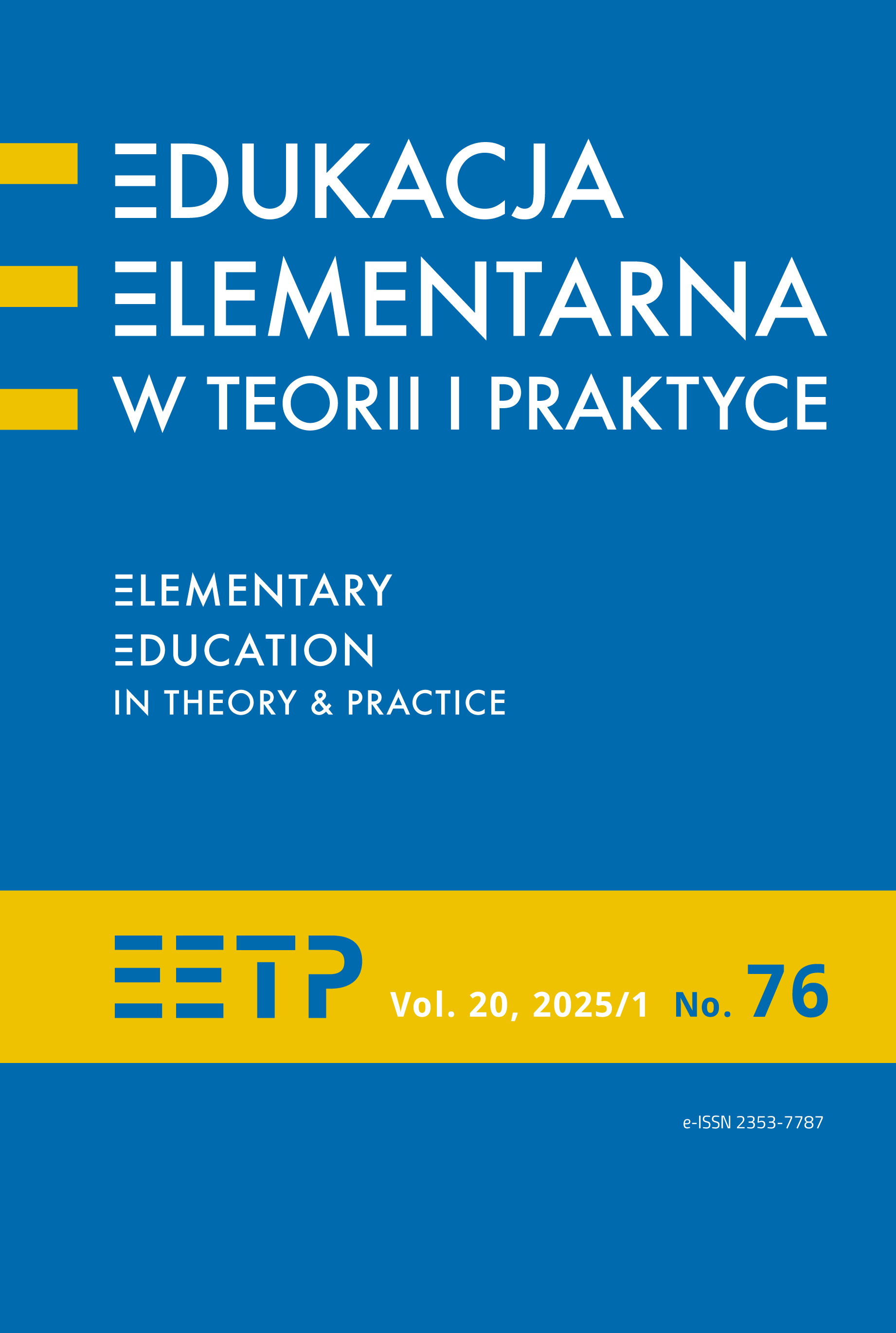Projekt „Ster na STEAM” - charakterystyka i wstępna ocena walorów estetycznych i edukacyjnych pakietu aplikacji do podłogi interaktywnej
Abstrakt
Artykuł przedstawia opis projektu „Ster na STEAM” zrealizowanego w ramach grantu pozyskanego z programu „Inkubator Innowacyjności 4.0” W roku 2022, uwzględniającego opracowanie interaktywnych aplikacji wspierających kompetencje z grupy STEAM i ich implementację do praktyki szkolnej. W tekście scharakteryzowano pakiet aplikacji oraz przedstawiono efekty wdrożenia go do procesu kształcenia i wychowania wczesnoszkolnego. Projekt dydaktyczny miał charakter eksperymentu o charakterze naturalnym. Zrealizowany został w jednej grupie, z pomiarem końcowym. Po okresie implementacji narzędzia nastąpiła jego ewaluacja, przeprowadzona metodą sondażu diagnostycznego, techniką ankiety z wykorzystaniem kwestionariusza. W sondażu wzięło udział 24 uczniów klasy II, w tym 14 dziewczynek i 7 chłopców. Głównym pytaniem badawczym, na które starano się znaleźć odpowiedź było: Jakie walory estetyczne i edukacyjne pakietu aplikacji interaktywnej Ster na Steam dostrzegają uczniowie biorący udział w projekcie. Badanie wykazało, iż zestaw aplikacji zachęca do aktywności poznawczej, wzbudza motywację do nauki, wzbogaca wiedzę i rozwija zainteresowania uczniów otaczającym światem. W ocenie uczniów, najbardziej atrakcyjnymi grami pakietu okazały się gra Kosmos oraz Dekory. Wszystkie gry w opinii dzieci cechuje wysoka jakość estetyczna. Zadania okazały się raczej łatwe dla uczniów klasy II. W opinii nauczyciela pakiet cechuje wysoka jakość merytoryczna, edukacyjna i estetyczna. Pakiet może mieć zastosowanie w szkołach, przedszkolach i centrach edukacyjno-terapeutycznych.
Bibliografia
Bilewicz-Kuźnia, B. i Centner-Guz, M. (2015). Natura, architektura i zabawa i zabawa jako źródła przeżyć estetycznych i odkryć geometrycznych. Problemy Wczesnej Edukacji, 4(31), 101–121. https://doi.org/10.5604/01.3001.0008.5650 .
Bruce, C. i Hawes, Z. (2015). The role of 2D and 3D mental rotator in mathematics for your children: What is it? Why does it matter? And what can we do about it? ZDM Mathematics Education, 47(3), 331–343.
Clements, D.H. i Sarama, J. (2007). Effects of a preschool mathematics curriculum: Summative research on the Building Blocks Project. Journal for Research in Mathematics Education, 38(2), 136–163.
Dudel, B. i Naruszewicz, A. (red.). Zbiór koncepcji zajęć „STEAM” dla klas I–III szkoły podstawowej. Studenci studentom. Wydział Nauk o Edukacji Uniwersytetu w Białymstoku. https://repozytorium.uwb.edu.pl/jspui/bitstream/11320/13996/1/Zbior_koncepcji_zajec_STEAM.pdf
Filipiak, E. (2018), Badanie potencjału możliwości uczenia się dzieci – eksperyment nauczający. Problemy Wczesnej Edukacji, 3(42), 60–71. https://doi.org/10.26881/pwe.2018.42.07
Lamri, J. (2021). Kompetencje XXI wieku. Kreatywność, komunikacja, krytyczne myślenie, kooperacja (A. Zręda, tłum.). Wolters Kluwer.
Mińkowska, E. (2021). Gry komputerowe w edukacji STEAM – możliwości i przeszkody. Edukacja Elementarna w Teorii i Praktyce, 16(63), 69–78. https://doi.org/10.35765/eetp.2021.1663.05
Montessori, M. (2010). Praksishandbuch der Montessori Methode. Herder Verlag.
Montessori, M. (2014). Odkrycie dziecka (A. Pluta, tłum.). Wydawnictwo Palatum.
Plebańska, M. (2018). STEAM – edukacja przyszłości. Teorie i badania. Mazowiecki Kwartalnik Edukacyjny Meritum, 4(51), 2–7.
Plebańska, M. i Szyller, A. (2024). STEAM-owa szkoła. Difin.
Samborska, I. (2019). Edukacja STEAM a aktywność poznawcza dziecka w wieku przedszkolnym. Edukacja Elementarna w Teorii i Praktyce, 14(54), 49–59. https://doi.org/10.35765/eetp.2019.1454.04
Samborska, I. (2024). STEM/STEAM w edukacji na rzecz zrównoważonego rozwoju w świetle dokumentów UE. Edukacja Elementarna w Teorii i Praktyce, 19(75), 11–21. https://doi.org/10.35765/eetp.2024.1975.01
Szkoła Podstawowa Fundacji Szkolnej (b.d.). Projekt “STEAM edukacja w każdej szkole”. https://sp.fundacjaszkolna.edu.pl/projekty
Szkoła Podstawowa nr 7 w Świdniku (b.d.). Świat Nauki i Ekologii: Siódemka Gości Erasmusa na Warsztatach STEMaction for The Future. Zespół Szkolno-Przedszkolny nr 1 w Świdniku. Szkoła Podstawowa nr 7 im. Żołnierzy Armii Krajowej w Świdniku. https://sp7.swidnik.pl/strona-3629-swiat_nauki_i_ekologii_siodemka_gosci.html
Szczęsny, W. (2008). Metodyka badań pedagogicznych i pisania prac dyplomowych. Wydawnictwo Akademickie „Żak”.
Zalecenie Rady z dnia 22 maja 2018 r. w sprawie kompetencji kluczowych w procesie uczenia się przez całe życie (Tekst mający znaczenie dla EOG.) (2018). Dz. U. UE. C 189 z 4.6.2018, s. 1–13. https://eur-lex.europa.eu/legal-content/PL/TXT/?uri=uriserv%3AOJ.C_.2018.189.01.0001.01.POL&toc=OJ%3AC%3A2018%3A189%3ATOC
Copyright (c) 2025 Edukacja Elementarna w Teorii i Praktyce

Utwór dostępny jest na licencji Creative Commons Uznanie autorstwa – Bez utworów zależnych 4.0 Międzynarodowe.
1. Autor zgłaszając swój artykuł oświadcza, że jest Autorem artykułu (zwanego dalej Utworem) i:
- przysługują mu wyłączne i nieograniczone prawa autorskie do Utworu,
- jest uprawniony/a do rozporządzania prawami autorskimi do Utworu.
Oświadcza, że nie narusza praw autorskich osób trzecich i praw prawnych.
Oświadcza, że nie występuje żaden konflikt interesów.
2. Udziela Uniwersytetowi Ignatianum w Krakowie nieodpłatnej, niewyłącznej, nieograniczonej terytorialnie licencji do korzystania z Utworu na następujących polach eksploatacji:
- utrwalania utworu w formie papierowej, a także na nośniku cyfrowym lub magnetycznym;
- zwielokrotnienia utworu dowolną techniką, bez ograniczenia ilości wydań i liczby egzemplarzy;
- rozpowszechniania utworu i jego zwielokrotnionych egzemplarzy na jakimkolwiek nośniku, w tym wprowadzenia do obrotu, sprzedaży, użyczenia, najmu;
- wprowadzenia utworu do pamięci komputera;
- rozpowszechniania utworu w sieciach informatycznych, w tym w sieci Internet;
- publicznego wykonania, wystawienia, wyświetlenia, odtworzenia oraz nadawania i reemitowania, a także publicznego udostępniania utworu w taki sposób, aby każdy mógł mieć do niego dostęp w miejscu i czasie przez siebie wybranym;
- w zakresie praw zależnych do Utworu, obejmujących w szczególności prawo do dokonania koniecznych zmian w Utworze, wynikających z opracowania redakcyjnego i metodycznego, a także do dokonania tłumaczenia Utworu na języki obce.
Udzielenie licencji następuje z chwilą przekazania Utworu na rzecz Uniwersytetowi Ignatianum w Krakowie. Uniwersytet Ignatianum w Krakowie jest uprawniony do udzielania dalszych sublicencji do Utworu, w zakresie udzielonego prawa. Licencja jest ograniczona czasowo i zostaje udzielona na okres 15 lat, licząc od daty jej udzielenia.
Wyraża się zgodę i zachęca autorów do publikacji ich tekstu w Internecie (np. w repozytorium instytucji lub na jej stronie internetowej) przed lub podczas procesu składania tekstu jako, że może to prowadzić do korzystnych wymian oraz wcześniejszego i większego cytowania opublikowanego tekstu (Patrz The Effect of Open Access). Zalecamy wykorzystanie dowolnego portalu stowarzyszeń badawczych z niżej wymienionych:




